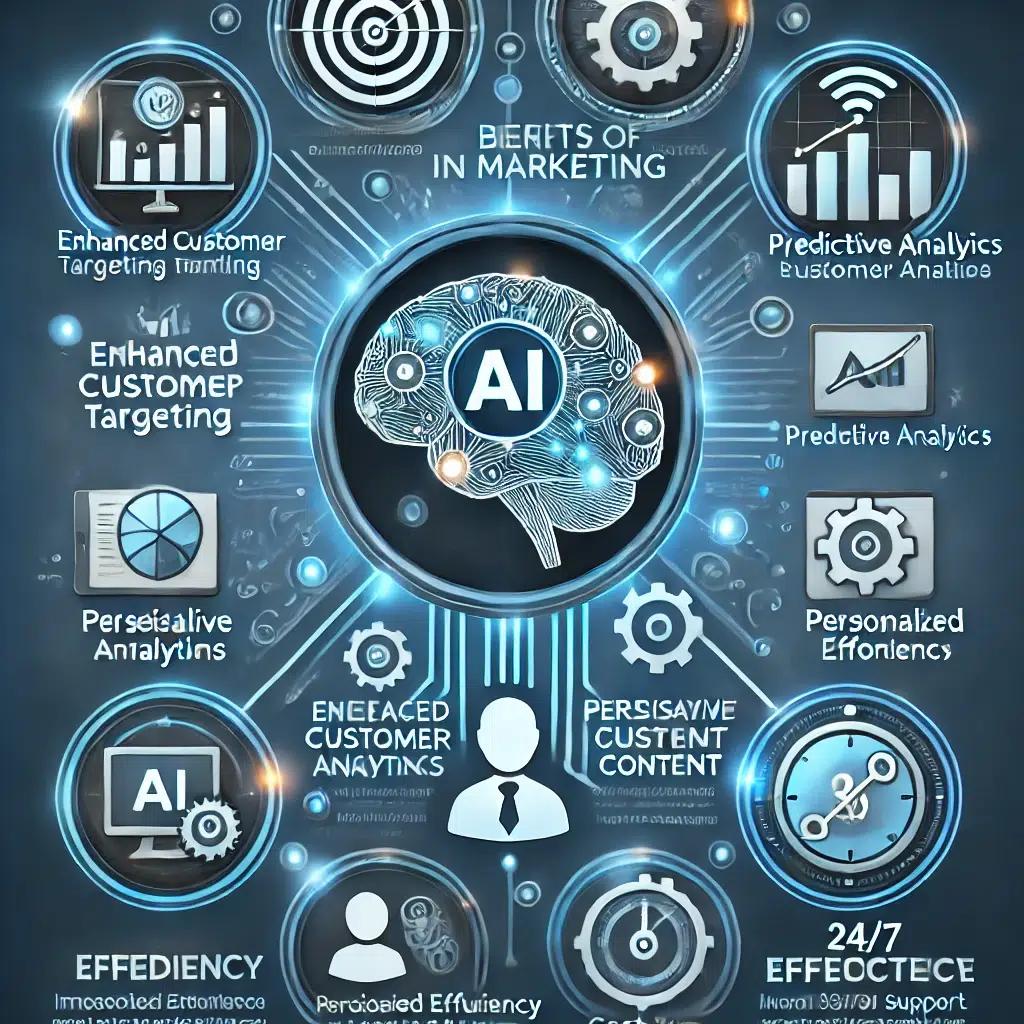
Artificial Intelligence (AI) is more than a trending topic—it’s rapidly shaping the way we live and work. Though it might sound futuristic, AI is already here, and it’s being woven into our daily lives in ways we don’t even realize. From creating content to optimizing ad strategies and streamlining operations, businesses are using AI to drive innovation and efficiency. While the benefits of AI tools are significant, understanding their limitations is equally (if not more) important. In this post, we’ll delve into how AI is transforming marketing and business, its advantages, and the pitfalls to consider when adopting these tools.
How is AI Already Being Used and What Are the Benefits?
AI is already being used in a variety of ways across industries, transforming how businesses operate and how individuals interact with technology. While many people associate AI with tools like ChatGPT, its applications extend far beyond creating content and answering queries. Here’s a deeper look at how it’s currently being used in marketing:
- Personalization: Platforms like email marketing tools, e-commerce websites, and social media use AI to tailor content and recommendations based on user behavior and preferences. For instance, marketing emails can recommend products based on past purchases or generate unique offer codes.
- Predictive Analytics & Data-Driven Insights: AI excels at analyzing large amounts of data to identify patterns and predict future trends. Businesses use predictive analytics to forecast demand, optimize inventory, and anticipate customer needs.
- Content Creation & Optimization: Beyond generating text, AI can help businesses create engaging and optimized content. Tools powered by AI can assist with writing blog posts, generating social media captions, and even designing visuals. Additionally, AI that is integrated into social media platforms can analyze content performance, suggesting improvements like better headlines, ideal posting times, or more effective calls-to-action to maximize engagement.
- Ad Buying: AI has changed digital advertising through tools like Google’s Performance Max. These systems use machine learning to automate and optimize ad placements, budgets, and targeting strategies across platforms. By analyzing user behavior and real-time data, AI aims to place ads that reach the right audience at the right time, increasing return on investment.
- Social Media Management: Managing multiple social media platforms is streamlined with AI tools. These tools can schedule posts, analyze audience engagement, and generate insights into trending topics or optimal posting times.
AI automates repetitive tasks that previously required significant time and resources. It can improve workflow efficiency and allow marketers and business owners to focus on strategic efforts rather than labor intensive tasks. By automating these processes, businesses can save on operational costs while achieving faster turnaround times. AI can help harness and analyze data to ensure marketing efforts are more precise, impactful, and aligned with business goals, which in the long run saves time and money. It also can improve the user experience by delivering personalized and seamless experiences.
Challenges and Pitfalls
While AI offers significant benefits when used thoughtfully, its application in marketing also presents notable challenges. One major concern is the loss of the human touch—overly automated interactions can feel impersonal and fail to build genuine connections with target audiences. It’s essential to remember that AI is a tool, not a replacement for human expertise. For example, when AI is used to write content, it often lacks the nuance and emotional resonance that skilled human writers bring. Content generated solely by AI can feel detached, and even search engines may penalize overly automated, low-quality output. AI excels in supporting the initial stages of content creation, such as generating ideas, structuring outlines, and handling technical tasks like grammar checks. However, it falls short in crafting compelling, emotionally engaging, and context-aware content.
To illustrate this point, I asked ChatGPT to create a graphic about the benefits of using AI in marketing. The result is disappointing to say the least. It contains a plethora of errors, doesn’t contain useful information, and isn’t visually appealing. The graphic also lacks the depth and critical thinking that a human designer would naturally incorporate.

This example reveals an important truth: AI doesn’t think like humans. It lacks emotions, intuition, and the ability to consider broader contexts or subtle factors. While AI has advanced significantly, it cannot replace the creativity, empathy, and critical judgment of skilled professionals. Instead, it should be viewed as a valuable assistant, augmenting human effort rather than replacing it.
Bias in algorithms is another significant challenge, as AI systems trained on skewed or incomplete data can perpetuate and even amplify biases, resulting in potentially inaccurate or unfair outcomes. AI is not without flaws—it can make mistakes, produce incorrect information, or offer misleading insights, which can harm decision-making and erode customer trust. Addressing these issues requires a balanced approach that incorporates human oversight, prioritizes diverse and unbiased data during training, and acknowledges AI’s limitations while maximizing its strengths.
As AI tools continue to advance, they are set to revolutionize how we approach marketing strategies and SEO. With the rise of AI powered search engines like SearchGPT, traditional search engines could face disruption, potentially pushing out Google as the leader. These tools can provide more direct answers to user queries, often accompanied by credible sources, eliminating the need to sift through multiple search results to find what you are looking for. This shift will require business owners and marketers to adapt quickly. The ability to learn and evolve is essential for staying ahead in the marketing game. Embracing change and leveraging new tools will allow marketers to navigate this evolving environment, rather than resisting the inevitable changes in technology.
Key Takeaways
AI offers businesses tools to enhance personalization, streamline processes, and improve decision-making through data-driven insights. From content creation and predictive analytics to ad buying and social media management, AI empowers marketers to work more efficiently and effectively. However, its use is not without challenges. Over-reliance on AI can lead to impersonal interactions, loss of the human touch, and errors stemming from biases or incomplete data.
To maximize AI’s potential, it’s critical to pair its capabilities with human oversight and creativity. While AI excels at automation and analysis, it cannot replicate the emotional intelligence and context-awareness of skilled professionals. As the industry evolves with innovations like conversational search engines, marketers and businesses must stay adaptable, embracing AI as a complementary tool rather than a standalone solution. This balanced approach will ensure businesses remain competitive while maintaining authenticity and connection with their audiences.
If you’re interested in learning more about how to appropriately leverage AI tools, reach out to us to start the conversation.

About the Author
McKell Michaelson is a Digital Marketing Specialist at Zykin Design dedicated to driving business growth, maximizing ROI, and increasing brand visibility through strategic and thorough online marketing campaigns.


